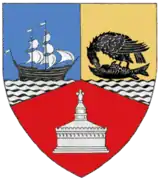Hârșova
Hârșova (also spelled Hîrșova; Romanian pronunciation: [ˈhɨrʃova]; Bulgarian: Хърсово, Harsovo) is a town located on the right bank of the Danube, in Constanța County, Northern Dobruja, Romania.
Hârșova | |
|---|---|
 | |
 Coat of arms | |
 Location in Constanța County | |
 Hârșova Location in Romania | |
| Coordinates: 44°41′0″N 27°57′7″E | |
| Country | |
| County | Constanța |
| Subdivisions | Vadu Oii |
| Government | |
| • Mayor | Viorel Ionescu[1] (ALDE) |
| Population (2011)[2] | 9,642 |
| Time zone | EET/EEST (UTC+2/+3) |
| Vehicle reg. | CT |
| Website | www |
The village of Vadu Oii is administered by the town. The village is linked with Giurgeni commune over the Danube via the Giurgeni-Vadu Oii Bridge.
Etymology
The relationship between the current name of Hârșova and the ancient name of the city, Carsium has long been a matter of debate among historians and linguists.[3] According to Iorgu Iordan the ancient name may have been kept under the influence of the Slavic word Круш, cliff, rock.[3]
The current name may also derive from the ancient Slavic god Hârs (Хърс) and Slavic suffix "-ova" and it is still under debate whether it is in any way linked with the ancient name, or perhaps a common proto-indo-european root related to "ecstasy"/"desire", ultimately also related to the vedic rta and avestan arta.[4]
History
In ancient times, a Roman settlement named Carsium, belonging to the Scythia Minor province, lay on the current site of the town.
In 1853, The Times of London reported that "Hirsova"
is defended by a fortified castle, and has a garrison of abouit 2,000 men. This place was taken by the Russians in 1809 and 1828. Though small, it is of considerable importance from its position on the very spot where the Berchicha returns to the Danube. . . . It is in many parts inundated, but has good pasturage for the excellent horses which constitute the sole wealth of the Tartars who inhabit it.[5]
Demographics
| Year | Pop. | ±% |
|---|---|---|
| 1912 | 3,990 | — |
| 1930 | 3,665 | −8.1% |
| 1948 | 3,762 | +2.6% |
| 1956 | 4,761 | +26.6% |
| 1966 | 7,519 | +57.9% |
| 1977 | 8,239 | +9.6% |
| 1992 | 10,394 | +26.2% |
| 2002 | 11,198 | +7.7% |
| 2011 | 9,642 | −13.9% |
| Source: Census data | ||
At the 2011 census, Hârșova had 7,476 Romanians (84.47%), 6 Hungarians (0.07%), 490 Roma (5.54%), 829 Turks (9.37%), 9 Tatars (0.10%), 27 Lipovans (0.31%), 4 others (0.05%), 9 with undeclared ethnicity (0.10%).
Gallery
 Ruins of Carsium
Ruins of Carsium Ruins of Carsium
Ruins of Carsium Lipovan Church
Lipovan Church Residential buildings in Hârșova
Residential buildings in Hârșova
See also
References
- "Rezultate finale în judeţul Constanţa. Iată care sunt noii primari din judeţ!" (in Romanian). Ziua de Constanța. 6 June 2016. Retrieved 6 June 2016.
- "Populaţia stabilă pe judeţe, municipii, oraşe şi localităti componenete la RPL_2011" (in Romanian). National Institute of Statistics. Retrieved 4 February 2014.
- Iordan, Iorgu (1963). Toponimia romînească. Bucharest: Editura Academiei Republicii Populare Romîne. p. 89. OCLC 460710897.
- Constantine Borissoff, Non-Iranian origin of the Eastern-Slavonic god Xŭrsŭ/Xors, November 2014
- "The Seat of War on the Danube," The Times, December 29, page 8
External links
| Wikimedia Commons has media related to Hârșova. |
